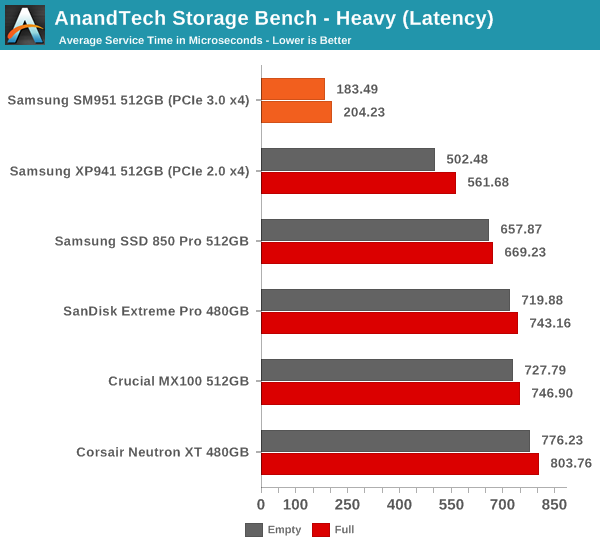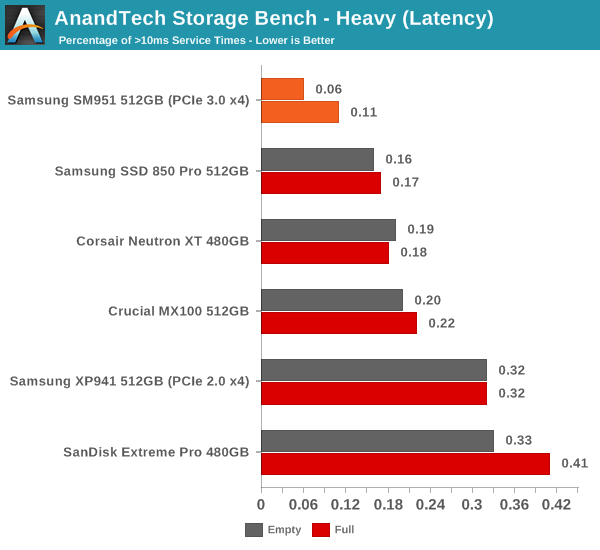Samsung SM951 (512GB) PCIe SSD Review
by Kristian Vättö on February 24, 2015 8:00 AM ESTAnandTech Storage Bench - Heavy
While The Destroyer focuses on sustained and worst-case performance by hammering the drive with nearly 1TB worth of writes, the Heavy trace provides a more typical enthusiast and power user workload. By writing less to the drive, the Heavy trace doesn't drive the SSD into steady-state and thus the trace gives us a good idea of peak performance combined with some basic garbage collection routines.
| AnandTech Storage Bench - Heavy | ||||||||||||
| Workload | Description | Applications Used | ||||||||||
| Photo Editing | Import images, edit, export | Adobe Photoshop | ||||||||||
| Gaming | Pllay games, load levels | Starcraft II, World of Warcraft | ||||||||||
| Content Creation | HTML editing | Dreamweaver | ||||||||||
| General Productivity | Browse the web, manage local email, document creation, application install, virus/malware scan | Chrome, IE10, Outlook, Windows 8, AxCrypt, uTorrent, AdAware | ||||||||||
| Application Development | Compile Chromium | Visual Studio 2008 | ||||||||||
The Heavy trace drops virtualization from the equation and goes a bit lighter on photo editing and gaming, making it more relevant to the majority of end-users.
| AnandTech Storage Bench - Heavy - Specs | ||||||||||||
| Reads | 2.17 million | |||||||||||
| Writes | 1.78 million | |||||||||||
| Total IO Operations | 3.99 million | |||||||||||
| Total GB Read | 48.63 GB | |||||||||||
| Total GB Written | 106.32 GB | |||||||||||
| Average Queue Depth | ~4.6 | |||||||||||
| Focus | Peak IO, basic GC routines | |||||||||||
The Heavy trace is actually more write-centric than The Destroyer is. A part of that is explained by the lack of virtualization because operating systems tend to be read-intensive, be that a local or virtual system. The total number of IOs is less than 10% of The Destroyer's IOs, so the Heavy trace is much easier for the drive and doesn't even overwrite the drive once.
| AnandTech Storage Bench - Heavy - IO Breakdown | |||||||||||
| IO Size | <4KB | 4KB | 8KB | 16KB | 32KB | 64KB | 128KB | ||||
| % of Total | 7.8% | 29.2% | 3.5% | 10.3% | 10.8% | 4.1% | 21.7% | ||||
The Heavy trace has more focus on 16KB and 32KB IO sizes, but more than half of the IOs are still either 4KB or 128KB. About 43% of the IOs are sequential with the rest being slightly more full random than pseudo-random.
| AnandTech Storage Bench - Heavy - QD Breakdown | ||||||||||||
| Queue Depth | 1 | 2 | 3 | 4-5 | 6-10 | 11-20 | 21-32 | >32 | ||||
| % of Total | 63.5% | 10.4% | 5.1% | 5.0% | 6.4% | 6.0% | 3.2% | 0.3% | ||||
In terms of queue depths the Heavy trace is even more focused on very low queue depths with three fourths happening at queue depth of one or two.
I'm reporting the same performance metrics as in The Destroyer benchmark, but I'm running the drive in both empty and full states. Some manufacturers tend to focus intensively on peak performance on an empty drive, but in reality the drive will always contain some data. Testing the drive in full state gives us valuable information whether the drive loses performance once it's filled with data.

The SM951 performs even strongly in our Heavy trace and presents nearly 100% improvement in data rate over the XP941. In full state the SM951 loses a bit of its performance, but that's normal and the drop isn't any bigger than in other drives. Despite the lack of NVMe, it's starting to be clear that the SM951 is significantly faster than its predecessor and any SATA 6Gbps SSD.

The average latency is also cut in less than half, which is actually a more substantial improvement than going from a SATA 6Gbps drive to the XP941.

The share of high latency IOs is also the lowest with only 0.06% of the IOs having a higher than 10ms service time.










128 Comments
View All Comments
hojnikb - Tuesday, February 24, 2015 - link
Quick question;Is anyone going beyond that limit on 2D nand ?
Kristian Vättö - Tuesday, February 24, 2015 - link
I don't think anyone has stacked more than 16 dies currently. Right now Samsung is the only one shipping 16-die packages in volume, whereas others are either still developing or only shipping in very limited quantities (e.g. Toshiba's 16-die packages are ~3x more expensive in terms of $/GB).baii9 - Tuesday, February 24, 2015 - link
great review and new test suite, on the mx100 I mean. Clearly show that top tier ssds( 850 pro, extreme pro) is hardly better than a budget drive. would be awesome if you guys can throw arc 100 into the mix.Kristian Vättö - Tuesday, February 24, 2015 - link
I was only able to test a bunch of drives for this review and chose the drives that I found the most relevant, but the ARC 100 will definitely be tested soon.hojnikb - Tuesday, February 24, 2015 - link
yeah, that would be great.ARC 100 is getting cheaper every day here in EU and its currently the best buy in ~256GB segment.
danjw - Tuesday, February 24, 2015 - link
Since there are multiple form factors, it would be nice if you included the form factor for M.2 drives.Kristian Vättö - Tuesday, February 24, 2015 - link
It's mentioned right after the table, but I've also added it to the table now so it can't be missed.danjw - Tuesday, February 24, 2015 - link
Thanks!aggiechase37 - Tuesday, February 24, 2015 - link
Yeah, but if something goes terribly wrong with the drive, can we trust Samsung to do the right thing? Replace the 840 EVO's, or Samsung, you're dead to me.aggiechase37 - Tuesday, February 24, 2015 - link
So the only way to get a Samsung #fail drive is to get a Lenovo #spyware laptop? Let me just jump right all over that.